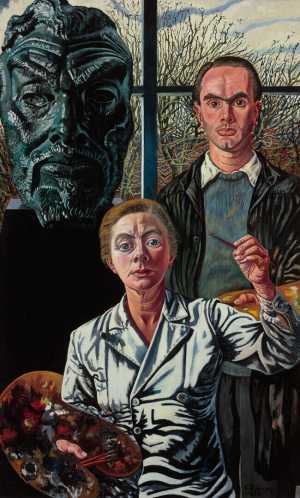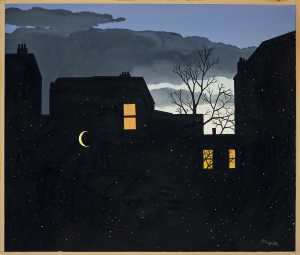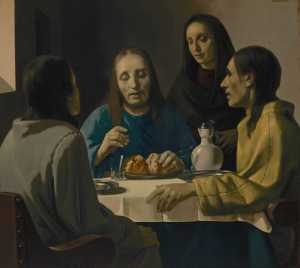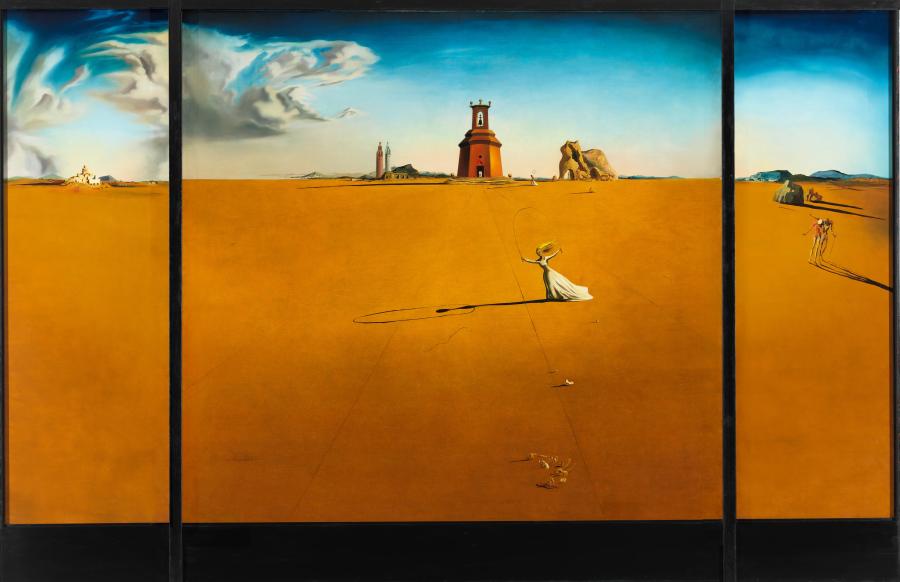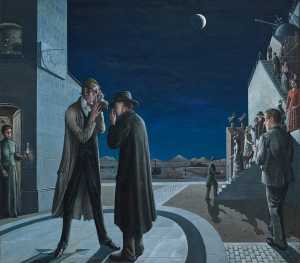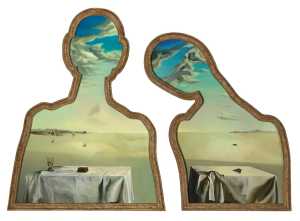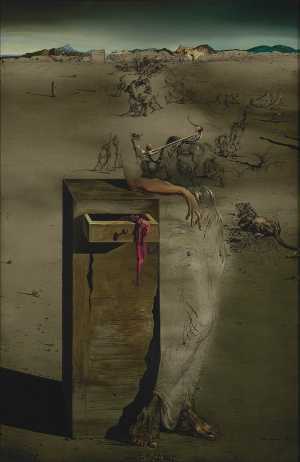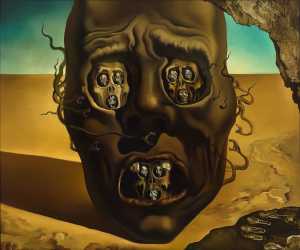Dalí made this triptych for the house of Edward James, the eccentric Englishman who supported him financially. The girl with a skipping rope symbolises a happy childhood memory. Her form is echoed by that of the bell in the tower. The figures on the right, one half skinned, could be Dalí and his dead older brother after whom he was named.

Specifications
| Title | Landscape with a Girl Skipping Rope |
|---|---|
| Material and technique | Oil on canvas |
| Object type |
Painting
> Painting
> Two-dimensional object
> Art object
|
| Location | This object is travelling |
| Dimensions |
Height 301,4 cm Width 466,5 cm Depth 10,5 cm |
|---|---|
| Artists |
Artist:
Salvador Dalí
|
| Accession number | 2937 a-c (MK) |
| Credits | Purchased 1977 |
| Department | Modern Art |
| Acquisition date | 1977 |
| Creation date | in 1936 |
| Collector | Collector / Edward James |
| Entitled parties | © Salvador Dalí, Fundación Gala-Salvador Dalí, c/o Pictoright Amsterdam 2022 |
| Provenance | Edward James, Chichester 1936-64; Edward James Foundation, Chichester 1964-77; left and right panels on loan to Tate Gallery, London 1958-72; Triptych on loan to Museum Boijmans Van Beuningen, Rotterdam 1972-77 |
| Exhibitions | Rotterdam 1972a; Charleroi 1985; Stuttgart/Zurich/Humlebaek 1989-90; London/Rotterdam/Bilbao 2007-08; Milan 2010-11; Paris/Madrid 2012-13; Rotterdam 2013-14a; Edinburgh/Hamburg/Rotterdam 2016-17 |
| Internal exhibitions |
Openbare restauratie schilderij Dalí (2010) Een paraplu, een naaimachine en een ontleedtafel. Surrealisme à la Dalí in Rotterdam. (2013) Gek van surrealisme (2017) |
| External exhibitions |
Surreal Encounters - Collecting the Marvellous (2016) Dalí (2012) Dalí, Ernst, Miró, Magritte... (2016) Boijmans x KMSKA. Bruikleen t.b.v. nieuwe opstelling KMSKA (2022) Dal nulla al sogno (2018) |
| Research |
Show research A dream collection - Surrealism in Museum Boijmans Van Beuningen |
| Literature | Descharnes 1997, p. 201; Stuttgart/Zurich 1989, p. 189, cat. no. 146; Gibson 1997b, p. 350, fig. 81; Figueres 2004-present, no. 419; Milan 2010-11, pp. 160-61; Paris/Madrid 2012-13, p. 204; Edinburgh 2016, p. 215, cat. no. 32 |
| Material | |
| Object | |
| Geographical origin | Spain > Southern Europe > Europe |
Do you have corrections or additional information about this work? Please, send us a message
Entry catalogue A dream collection - Surrealism in Museum Boijmans Van Beuningen
Author: Marijke Peyser
Viewers’ first response to this painting is usually surprise at its huge size – almost three metres high and more than four metres wide – and its triptych form. And then there is the great emptiness that focuses all the attention on the frail little figure in the centre: Carolina Barnadas Ferrés. Carolina, known as Carolinetta, was the unmarried daughter of the sister of Salvador Dalí’s grandmother Carolina. Carolinetta died of meningitis on 22 December 1914 at the age of thirty-four.[1] The telegram announcing her death was read out to the family during dinner by Dalí’s father, a notary in Figueres. Dalí’s grandmother was heartbroken. The ten-year-old Dalí, however, went on eating impassively.[2] It was only later, in the 1930s, that the artist came to terms with the loss of this beloved member of the family in numerous paintings and drawings of a frail, romantically dressed woman with a skipping-rope.[3]
On the centre panel Dalí depicted a chapel in a building style typical of Catalonia. At the same time this structure calls to mind the little temple in The Marriage of the Virgin (1504), a painting by the Italian master Raphael whom Dalí so admired. The church bell echoes the silhouette of the girl skipping. The two towers on the left of the church allude to Dalí’s discovery that the church towers of Gerona and Delft resembled one another.[4] In the background of the left shutter is the little town of Cadaqués. Two half-naked stooping figures wandering across the desolate plain on the right may be an allusion to the expulsion of Adam and Eve from the Garden of Eden.
Dalí probably met the immensely wealthy English art lover and patron Edward James in the summer of 1933.[5] In 1936 James had a contract drawn up giving him the rights to all the works Dalí made between 1 July 1936 and 1 July 1938. Dalí and James signed the agreement on 21 December 1936, although the conditions did not take effect until 1 June 1937.[6] Nevertheless this large triptych, painted in 1936, is part of the output from that period.
Initially the triptych hung at 35 Wimpole Street, James’s London residence. During the Second World War a bomb fell on the roof of the house and damaged the middle section of the triptych.[7] This canvas was immediately transferred to James’s country house in Sussex. The two side panels are part of a group of twenty works from James’s collection that were loaned to the Tate Gallery (now the Tate) on 27 August 1958. At the end of June 1972 these works left this museum and were restored by Holder & Sons in London.[8] Some months later the restored side panels were taken to Sussex, where the three canvases were reunited. On 27 October 1972 the triptych arrived in Rotterdam as a long-term loan. Its purchase followed five years later.
Footnotes
[1] Gibson 1997b, pp. 82-83.
[2] Stuttgart/Zurich 1989, p. 136.
[3] Écho nostalgique (1935), Banlieue de la ville paranoïaque-critique (1935); Paysage païen moyen (1937).
[4] Stuttgart/Zurich 1989, p. 170: Dalí was also an admirer of Johannes Vermeer. He portrayed him several times: Eléments énigmatiques dans un paysage (1934), Le spectre de Vermeer pouvant être utilisé comme table (c. 1934), Spectre de Vermeer de Delft (c. 1934), Le spectre de Vermeer de Delft (c. 1934), Apparition de la ville de Delft (c. 1936).
[5] Gibson 1997b, p. 383.
[6] Ibid., p. 417 and Peyser-Verhaar 2008, see pp. 158-59 for Dalí’s obligations.
[7] The Edward James Foundation has a letter dating from 1961, from James to his secretary in Sussex, in which he says that the middle panel was damaged when a bomb ‘knocked off’ the roof of his house at 35 Wimpole Street London. See MBVB Archives, Dalí object file, Landscape with a Girl Skipping Rope.
[8] Email from Christopher Bastock, Tate Library & Archive, dated 14 May 2010. See MBVB Archives, Dalí object file, Landscape with a Girl Skipping Rope.
All about the artist
Salvador Dalí
Figueras 1904 - Figueras 1989
Salvador Dali got to know the author André Breton - the founder of the surrealist movement - while he was studying in Madrid. In 1924, Breton wrote the first...
Bekijk het volledige profiel

